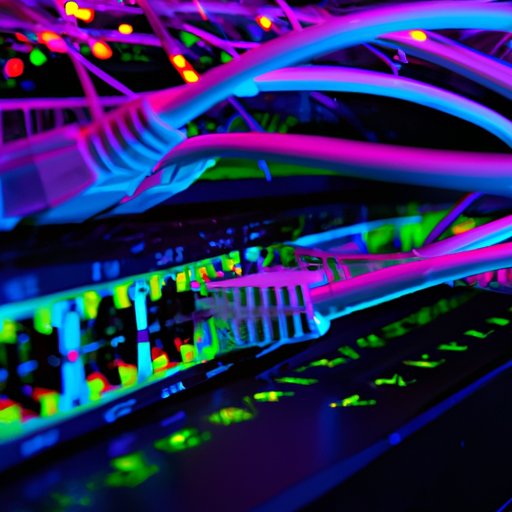Introduction
The internet is a global network of interconnected computers, servers, and other devices that communicate with each other over the internet. It enables people to access information, communicate, and share data across the globe. This article will explore how the internet works in detail, from an overview of the different hardware components to a step-by-step guide to understanding how it works. It will also examine the role of ISPs in connecting to the internet.
Explaining the Basics of Internet Technology
Before exploring how the internet works, it is important to understand what the internet is and the different types of networks that are used. The internet is a worldwide network of computers, servers, and other devices connected together using the Transmission Control Protocol/Internet Protocol (TCP/IP). This protocol is the basic language used by computers to communicate with each other over the internet.
The internet is made up of several different types of networks including local area networks (LANs), wide area networks (WANs), and metropolitan area networks (MANs). LANs are typically used within a single building or office, while WANs are used to connect two or more locations that are geographically distant. MANs are used to connect multiple LANs across a city.
Data is transmitted over the internet using packet switching. Packet switching is a technique where data is divided into small packets that are sent independently over the network. Each packet contains the address of its destination, which allows routers to route the packets to the correct destination.
A Step-by-Step Guide to Understanding How the Internet Works
To understand how the internet works, it is important to understand the different hardware components that make up the internet. These include computers, routers, switches, and cables. Computers are the devices that send and receive data over the internet. Routers are devices that direct traffic between different networks, while switches are used to connect multiple computers together.
Once the hardware components are in place, computers need to be able to communicate with each other. This is done using the TCP/IP protocol. This protocol is responsible for breaking down data into small packets and sending them over the network. Routers then use these packets to route the data to the correct destination.
Once the data reaches its destination, it needs to be reassembled. This is done using packet switching. Packet switching is a technique where data is divided into small packets, each containing the address of its destination. Routers then route the packets to the correct destination.

An Overview of the Different Protocols and Technologies Involved in the Internet
In addition to the TCP/IP protocol, there are several other protocols and technologies involved in the internet. The Domain Name System (DNS) is responsible for translating domain names into IP addresses. The Hypertext Transfer Protocol (HTTP) is used to transfer web pages from web servers to web browsers. Electronic mail (email) is used to send messages between computers.

Examining the Network Infrastructure of the Internet
The network infrastructure of the internet consists of several different components. To connect to the internet, users need to connect to a local area network (LAN). This can be done through a wired connection or a wireless connection. Once connected to the LAN, users can access the wider internet using a router.
The internet is also made up of wide area networks (WANs) which are used to connect two or more locations that are geographically distant. WANs are typically owned and operated by large telecommunications companies. They provide a connection to the internet for businesses, organizations, and individuals.

Investigating the Role of ISPs in Connecting to the Internet
To access the internet, users need to connect to an internet service provider (ISP). An ISP is a company that provides access to the internet. There are several different types of ISPs, including cable providers, DSL providers, and satellite providers. Each type of ISP offers different speeds and features, so users should research their options before choosing an ISP.
Conclusion
This article has explored how the internet works in detail, from an overview of the different hardware components to a step-by-step guide to understanding how it works. It has also examined the role of ISPs in connecting to the internet. By understanding the basics of internet technology, users can gain a better understanding of how the internet works and the different protocols and technologies involved.
(Note: Is this article not meeting your expectations? Do you have knowledge or insights to share? Unlock new opportunities and expand your reach by joining our authors team. Click Registration to join us and share your expertise with our readers.)
